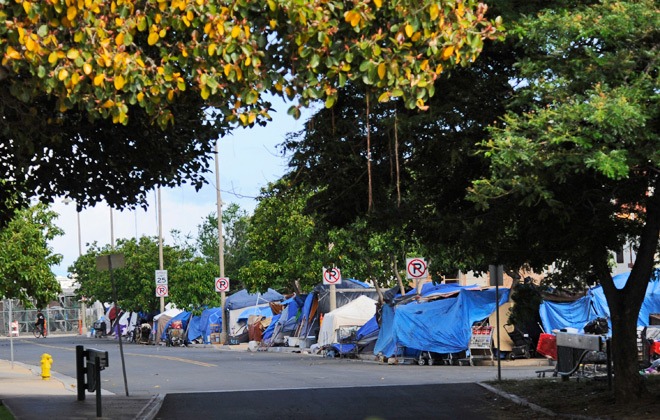City is pressed about homeless site

An area in Kakaako along Olomehani Street has attracted homeless people for years
The city plans to open a “safe haven” in the next month to accommodate the growing homeless population in Kakaako, Honolulu Managing Director Roy Amemiya said Thursday.
Amemiya divulged the plan, reluctantly, under questioning by members of the City Council Zoning and Planning Committee who voiced frustration at what they view as a lack of progress by the city in dealing with homelessness. They demanded that Amemiya provide a comprehensive picture of what the Caldwell administration is doing to address homelessness.
The project will be on government-owned land, although Amemiya would not say where it is, which government entity has authority over it, or even describe what a “safe haven” would entail. Pressed to give more details, both by committee members at the meeting and by the Honolulu Star-Advertiser afterward, he declined.
Citing the need to finalize details, Amemiya said Council members and the media would be informed “soon,” in the coming weeks.
The city and the state have come under increasing public pressure to ease the growing homeless presence in Kakaako since state Rep. Tom Brower was assaulted by two homeless youths while taking pictures of the encampment June 29. Brower, at a news conference at the homeless site Thursday, announced that he has decided to press charges against at least one of the two cousins.
Amemiya told the committee Thursday that the Caldwell administration has been meeting with key members of Gov. David Ige’s administration to work on some solutions, noting again that the city holds dual enforcement authority in Kakaako with the state Hawaii Community Development Authority.
Don't miss out on what's happening!
Stay in touch with breaking news, as it happens, conveniently in your email inbox. It's FREE!
The staffs of the governor and the mayor are being spurred to come up with solutions at the urging of Honolulu Police Chief Louis Kealoha, Amemiya said.
“Those discussions have been driven by the Honolulu Police Department, which is concerned by the potential violence that could occur because of the additional people who have moved into Kakaako,” he said. “The police chief made it very clear this is something we need to work very quickly and decisively on.”
The parties “have a plan to begin enforcing (sidewalk ordinances) in Kakaako, and as part of that, we are looking at sites where we can encourage people to move into,” Amemiya said. “When we do enforce, it’s going to be very important that the service providers (are) accompanying us or even be there ahead of us, so we can move people into transitional shelters.”
The city has been talking to the governor about possible sites “where additional shelters can be erected,” Amemiya said. “The state administration has come up with additional land that they think may be able to be used, even though there are no commitments at this time — not that I’m aware of.”
Those parcels, he said, “have not yet been vetted.”
Jodi Leong, a spokeswoman for Ige, said the governor and members of his administration “are leading productive discussions” with federal, state and city agencies, the business community, social service providers and housing specialists on different options for addressing the Kakaako homeless situation.
“After consultation with this range of stakeholders, the governor will release information that will reflect discussions on a way forward to address both short-term and long-term issues surrounding homelessness,” Leong said in a statement.
Amemiya was grilled by committee members Thursday when he testified against Bill 44, which would add College Walk Mall and Kila Kalikimaka Mall, both in the Aala-Kukui area just outside Chinatown, to the areas that are part of the city’s controversial sit-lie ordinance.
Since the administration put through the first sit-lie bill last year, covering all Waikiki sidewalks 24 hours a day, Council members have been gradually adding neighborhoods in their districts that have seen increases in homeless populations, ostensibly as a result of being forced out of areas where sit-lie is enforced.
Amemiya, on Thursday, reiterated the concerns of city attorneys that bans against sitting and lying on sidewalks best withstand constitutional challenges when imposed in areas where commerce is being impeded by sidewalk dwellers.
That’s when Council members began questioning him about what was being done to address homelessness in their own neighborhoods: Councilwoman Ann Kobayashi about Kapahulu, Councilwoman Carol Fukunaga about Chinatown, Councilman Joey Manahan about Kapalama Canal, and Councilman Trevor Ozawa about Kaimuki.
Besides Kakaako, Amemiya mentioned a plan to put senior rental housing on River Street, as well as the possibility that the Aiea Sugar Mill, a section of Varona Village in Ewa Villages and Waianae could be used as housing sites.
Despite Amemiya’s concerns, the committee voted to advance Bill 44, as well as Bill 46, which would ban camping, sleeping, erecting a tent or related activities along Oahu streams.
Meanwhile, Council Zoning Chairman Ikaika Anderson said he may reintroduce a measure that would make it illegal to sit or lie on any sidewalk anywhere on Oahu. The bill failed 5-4 last year after city attorneys raised strong concerns about its constitutionality.
Anderson asked for an impromptu show of hands for support of an islandwide ban from five colleagues gathered at Thursday’s meeting. Four raised their hands.



